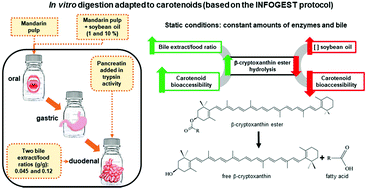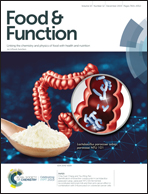Bile amount affects both the degree of micellarization and the hydrolysis extent of carotenoid esters during in vitro digestion†
Abstract
Carotenoid esters are present in considerable amounts in most fruits, such as in citrus. Although the bioavailability of carotenoid esters is similar or even higher compared to that of free carotenoids, these molecules are generally detected only in the free form in human plasma, suggesting that hydrolysis of carotenoid esters occurs in vivo. However, the available in vitro digestion methods were not able to achieve satisfactory carotenoid ester hydrolysis so far. As bile salts play an essential role in the hydrolytic action of lipolytic enzymes from pancreatin, we evaluated the effect of increasing the bile extract/food ratio from 0.045 to 0.12 (g g−1) on the hydrolysis of β-cryptoxanthin esters from mandarin pulp during in vitro digestion. Additionally, considering the positive effect of lipids on carotenoid bioavailability, the impact of soybean oil addition on carotenoid ester hydrolysis was studied. Finally, bioaccessibility and recovery of 33 carotenoids were assessed by LC-DAD-MS. The hydrolysis extent of β-cryptoxanthin esters enhanced from 29% to 55% by increasing the bile extract/food ratio, but reduced respectively to 28% and 11% by the addition of 1% and 10% oil (p < 0.05). The bioaccessibility of overall carotenoids improved from 19% to 35% by increasing the bile extract/food ratio, along with that of (all-E)-β-carotene (from 19 to 31%) and total (all-E)-β-cryptoxanthin (17% to 49%). Soybean oil addition reduced carotenoid micellarization, regardless of the concentration (p < 0.05). Irrespective of the bile extract amount and oil addition, the bioaccessibility of carotenoids was inversely related to its hydrophobicity, with respect to the following ranking: free xanthophylls > carotenes ≥ xanthophyll esters. Altogether, these results indicate that increasing the bile extract amount is a simple and inexpensive option to improve carotenoid ester hydrolysis in in vitro digestion protocols. Additionally, the constant amounts of bile (and possibly enzymes) of static methods, such as INFOGEST, should be further optimized for experiments involving lipid addition in which carotenoid bioaccessibility is evaluated.



 Please wait while we load your content...
Please wait while we load your content...